People in the Sundarbans of West Bengal, for long living on the edge, are now facing climate change – recurring cyclones, erratic rain, growing salinity, rising heat, depleting mangroves and more
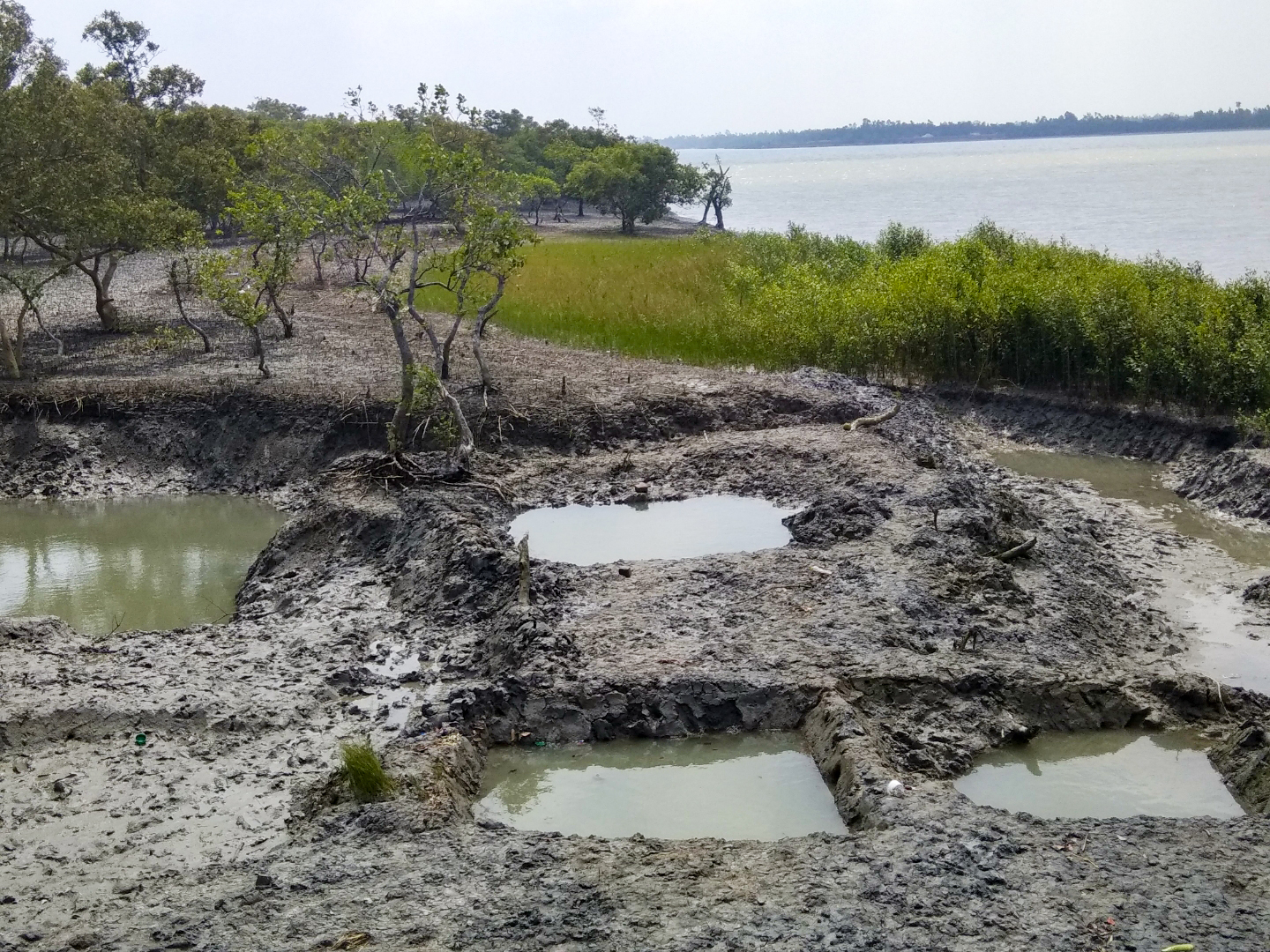
Urvashi Sarkar/PARI
Kajal Lata Biswas is still haunted by memories of the cyclone. Though it’s been 10 years since Aila hit the Sundarbans, she still clearly recalls May 25, 2009.
It was just before noon. “The [Kalindi] river water rushed into the village and flooded all the houses,” says Kajal Lata. She was at a relative’s house in Kumirmari village that day, around seven kilometres from her own village, Gobindakati. “Some 40-50 of us took shelter in a boat where we stayed the whole day and night. We watched trees, boats, cattle and paddy being swept away. At night, we could not see a thing. Even the matchsticks were soaked. We could see only when lightning flashed across the sky.”
Sitting outside her house and cleaning fish for lunch, 48-year-old Kajal Lata, a farmer, continues, “That night can never be forgotten. There wasn’t a drop of drinking water. Somehow, I collected a few raindrops in a plastic bag, which I used to wet the lips of my two daughters and niece, who were very thirsty.” Her voice shakes with the memory.
The next morning, they used a boat to to reach their village. Then waded through flood water to reach home. “Tanushree, my elder daughter, then 17, almost drowned where the water was very high. Luckily, she grabbed her aunt’s saree pallu which had come loose,” Kajal Lata says, her eyes relaying the fear she felt.
In May 2019, her fear returned with cyclone Fani, its arrival coinciding with the wedding of her younger daughter, 25-year-old Anushree.
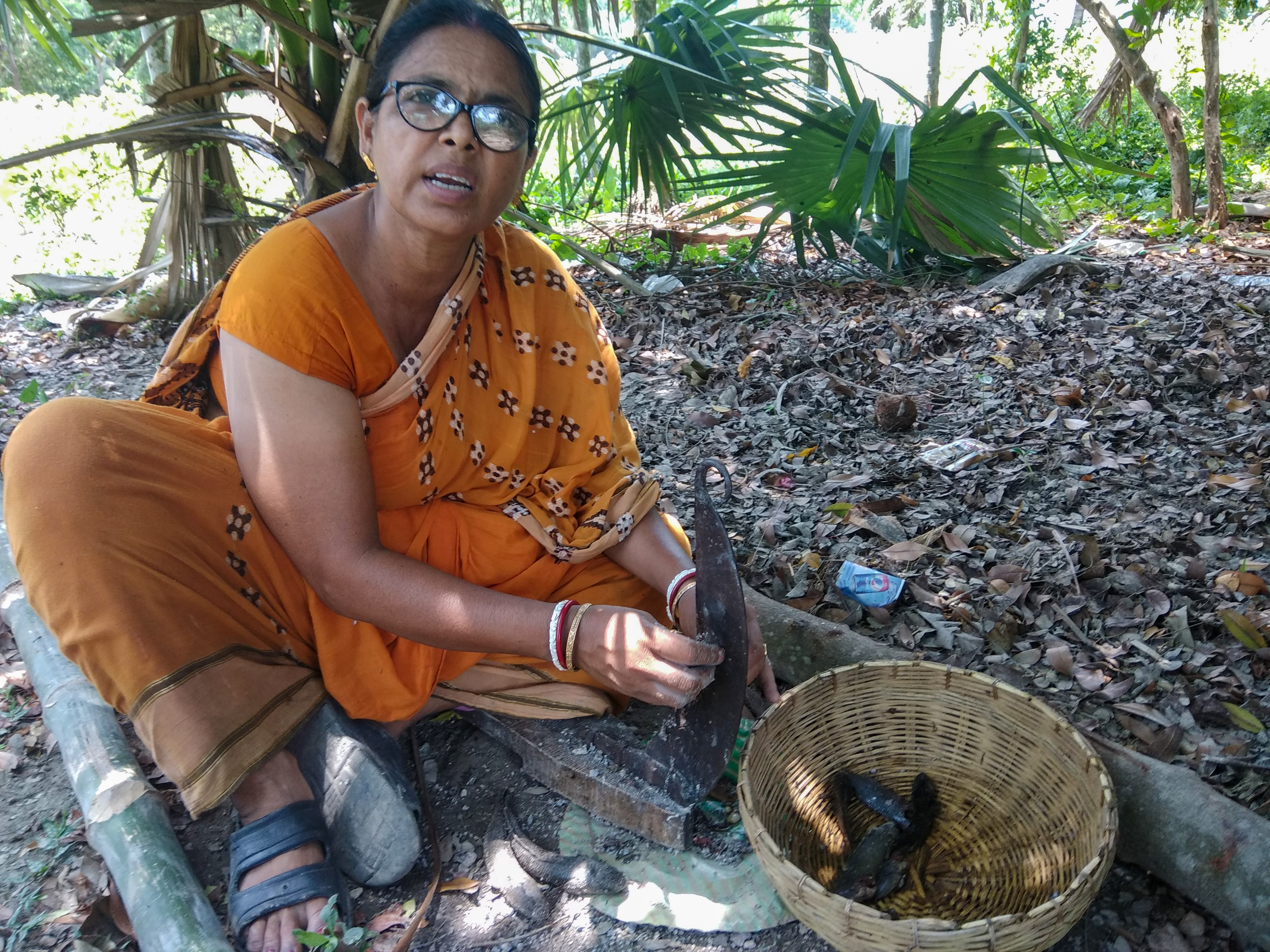
Kajal Lata Biswas, cleaning fish outside her house in Gobindakati village, recalls the terror of approaching cyclones. (Photo: Urvashi Sarkar/PARI)
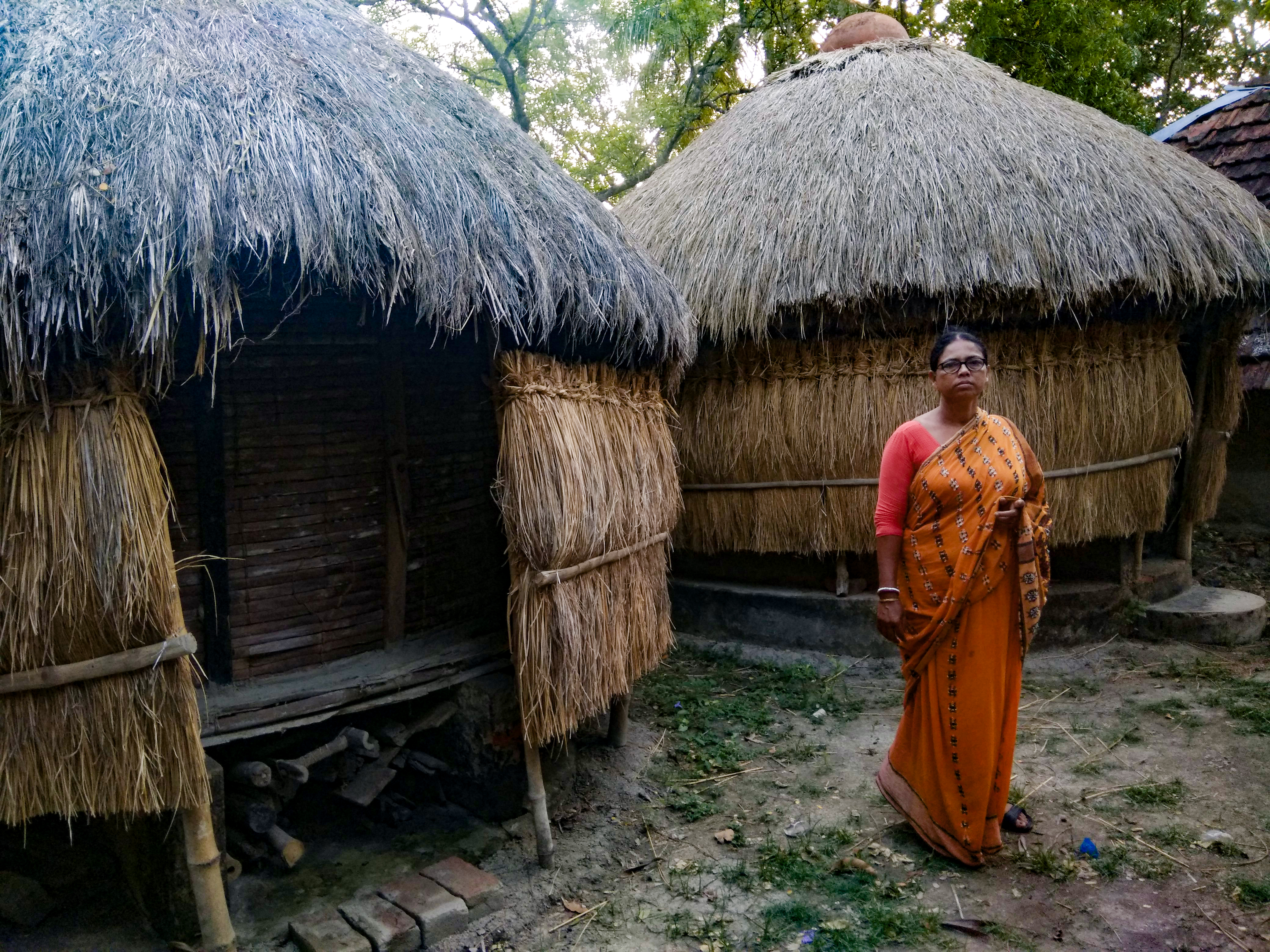
Paddy is stored in these huts in her village, and the crop has taken a hit. (Photo: Urvashi Sarkar/PARI)
The wedding was fixed for May 6. Loudspeaker announcements about Fani by the panchayat and on radio by the government had started a few days earlier. “Imagine our plight and fear,” Kajal Lata says. “We were terrified that winds and rain would destroy all the preparations. There was some rain in the days before the wedding. But thankfully, the cyclone did not affect our village,” she adds, clearly relieved.
On May 2, the India Meteorological Department had issued a warning about Fani hitting Andhra Pradesh, Odisha (which turned out to be the worst affected) and West Bengal. Talking about Fani, Prafulla Mondal, an 80-year-old farmer and former teacher in Rajat Jubilee village, raises his voice a few notches: “Fani missed the Sundarbans very narrowly. The winds whistled by us. If it had hit our village, we would have been destroyed, along with our houses and land…”
As both Mondal and Kajal Lata know only too well, cyclones are common in the Sundarbans. The Disaster Management and Civil Defence Department of the West Bengal government categorises both South and 24 North Parganas districts as ‘very high damage risk zones’ due to cyclones.
Mondal’s village is in Gosaba block of South 24 Parganas district, and Kajal Lata’s village is in North 24 Parganas district’s Hingalganj block. Both are among the 19 blocks which comprise the Indian Sundarbans in West Bengal – 6 blocks in North 24 Parganas and 13 in South 24 Parganas.
Spread across India and Bangladesh, the Sundarbans is a vast delta with perhaps the largest contiguous mangrove forest in the world – covering around 10,200 square kilometres. “The Sundarbans region is one of the richest ecosystems in the world…” says a 2014 report by the World Bank titled Building Resilience for the Sustainable Development of the Sundarbans. “The entire mangrove forest region is known for its exceptional biodiversity, including numerous threatened species such as the Royal Bengal tiger, estuarine crocodile, Indian python, and several species of river dolphin. It is home to more than 10 per cent of mammal and 25 percent of bird species found in India.”
The Indian Sundarbans – roughly 4,200 square kilometres – is also home to nearly 4.5 million people, many of whom live on the edge, struggling with meagre livelihoods, a harsh terrain and weather extremes.
Though the region has not seen a major cyclone after Aila, it remains severely vulnerable. A 2006 report by the Indian Institute of Technology, Kharagpur, done for the West Bengal government’s Department of Disaster Management, notes that the state experienced 71 cyclonic storms from the years 1891 to 2004. In that period, South 24 Pargana district’s Gosaba was the most affected block, with six severe cyclones and 19 cyclones.
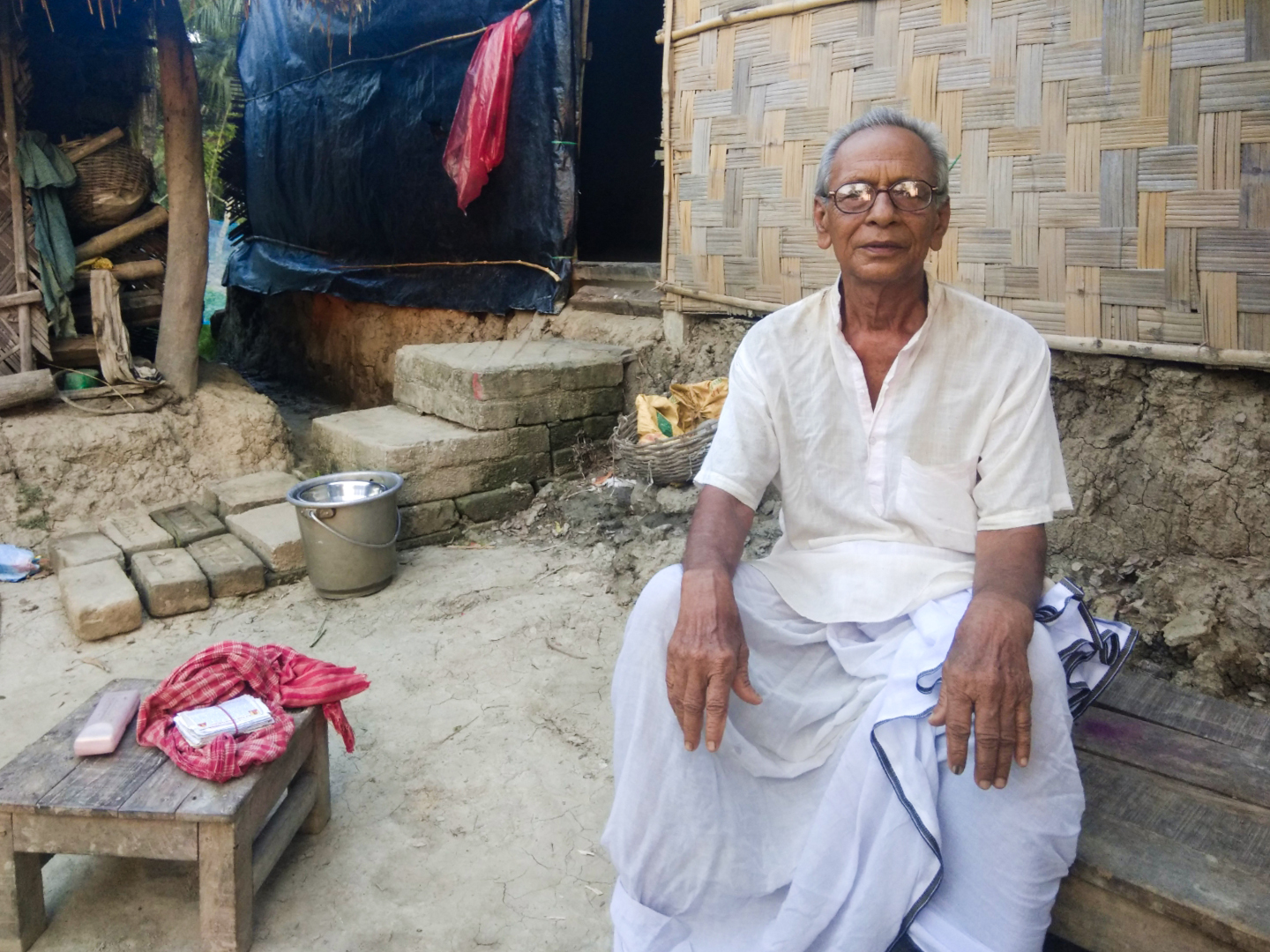
In Rajat Jubilee village, 80-year-old Prafulla Mondal has weathered many storms, but his family is now struggling with erratic weather changes. (Photo: Urvashi Sarkar/PARI)
Prafulla can thus recall cyclones even before Aila. “I cannot forget the 1998 cyclone [described as West Bengal’s ‘most intense storm’ since Independence, stronger even than Aila, which was a ‘severe cyclonic storm’] with its strong and violent winds. Before that too, I can remember the cyclone of 1988,” he says.
But even given this stormy past, cyclonic depressions (a tropical weather disturbance at sea, in the range of 31- 60 kilometres an hour, below the range of a cyclonic storm of 62-82 kilometres) have increased 2.5 times in the last 10 years in the lower Gangetic delta (where the Sundarbans are located), notes Dr. Abhijit Mitra, a Kolkata-based oceanographer, in a 2019 book titled Mangrove Forests in India. Exploring Ecosystem Services. “This means that cyclones occur more frequently,” he says.
Various other studies show that the incidence of cyclones has increased in the Bay of Bengal, alongside the Sundarbans. One study published in 2015 in the Diversity journal puts the increase at 26 per cent between 1881 and 2001. And using available data from 1877 to 2005 on cyclones in the Bay of Bengal during May, October and November, a 2007 study shows that the frequency of severe cyclonic storms here has registered significant increasing trends in past 129 years during these intense cyclonic months
In part, this is attributed to the increase in sea surface temperature (notes, among others, a paper in the Journal of Earth Science & Climate Change). These temperatures rose in the Indian Sundarbans at 0.5 degrees Celsius per decade from 1980 through 2007 – higher than the globally observed warming rate of 0.06° C per decade.
There have been several catastrophic fallouts. “While the Sundarbans last experienced a major cyclone in 2009,” says Prof. Sugata Hazra of the School of Oceanographic Studies at Jadavpur University, Kolkata, “the region has suffered because of repeated inundation and embankment failure owing to subsequent cyclones in the northern Bay of Bengal.”
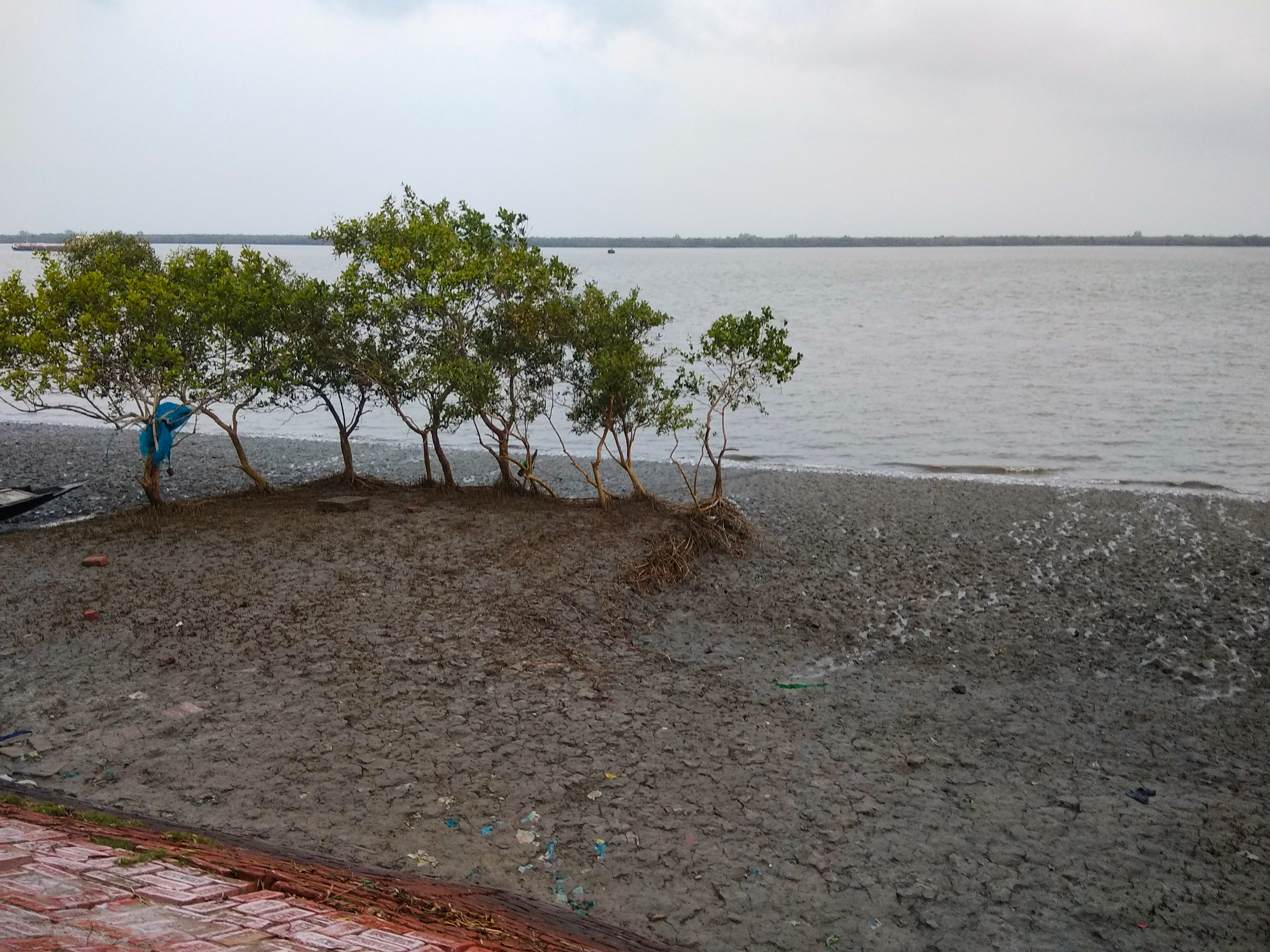
Rising sea levels and sea surface temperatures, among several other shifts, are threatening the Sundarbans. (Photo: Urvashi Sarkar)
Embankments, the World Bank report notes, “play a key role in the Sundarbans as systems of defense against cyclonic storms and sea level rise. The people and the productivity of their holdings are under increased threat from deltaic subsidence, sea level rise, and increased cyclone intensity as climate change and the decay of a 19th century 3,500-kilometer system of embankments take their toll…”
A 2011 World Wildlife Fund paper says that the relative mean sea level for 2002-2009 measured at the Sagar island observatory, Sundarbans, rose at the rate of 12 mm per year or at the rate of 8 mm per year for 25 years.
The warming and related sea level rise is also adverse affecting mangroves. These forests help protect coastal areas from cyclones and erosion, act as breeding ground for fish and other species, and are also the habitat of the Bengal Tiger. A 2010 paper by Jadavpur University’s School of Oceanographic Studies, titled Temporal Change Detection (2001-2008) Study of Sundarban notes that the rise in sea level and cyclones seriously affect the health of Sundarban’s mangrove forests by reducing the forest cover.
Arjun Mondal a fisherman from Rajat Jubilee village, was acutely aware of the importance of mangroves to the Sundarbans. He worked with an NGO, the Sundarbans Rural Development Society. “Everyone has heard of climate change, but how is it affecting us? We need to know more about this,” he told me in May 2019.
On June 29, 2019, Arjun was carried away by a tiger while hunting for crabs in the Pirkhali forest. While humans have for long been attacked by tigers in the Sundarbans, the increasing reports of attacks are at least partially due to the erosion of forest land caused by rising sea levels, bringing tigers in closer contact with inhabited villages.
With the battering of the region by cyclones, water salinity levels have also risen, especially in the central Sundarbans, where Gosaba is located. “…the ecosystem is being adversely impacted by significant increases in salinity due, in part, to sea level rise as well as reductions in freshwater flows to the delta,” notes the World Bank report.
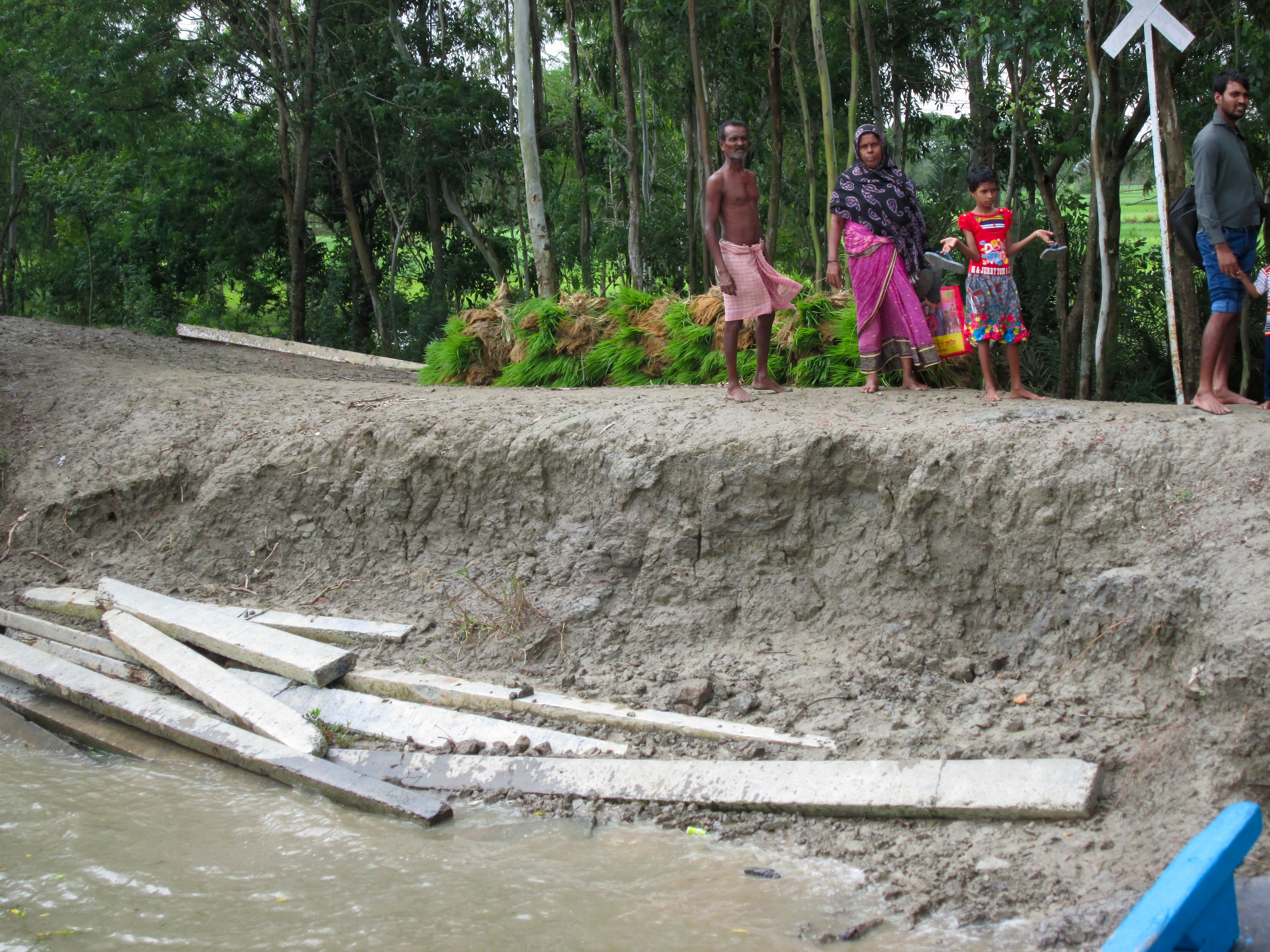
The extensive embankments in the Sundarbans, crucial to farming and controlling soil salinity, are steadily being eroded by the rising sea levels. (Photo: Urvashi Sarkar/PARI)
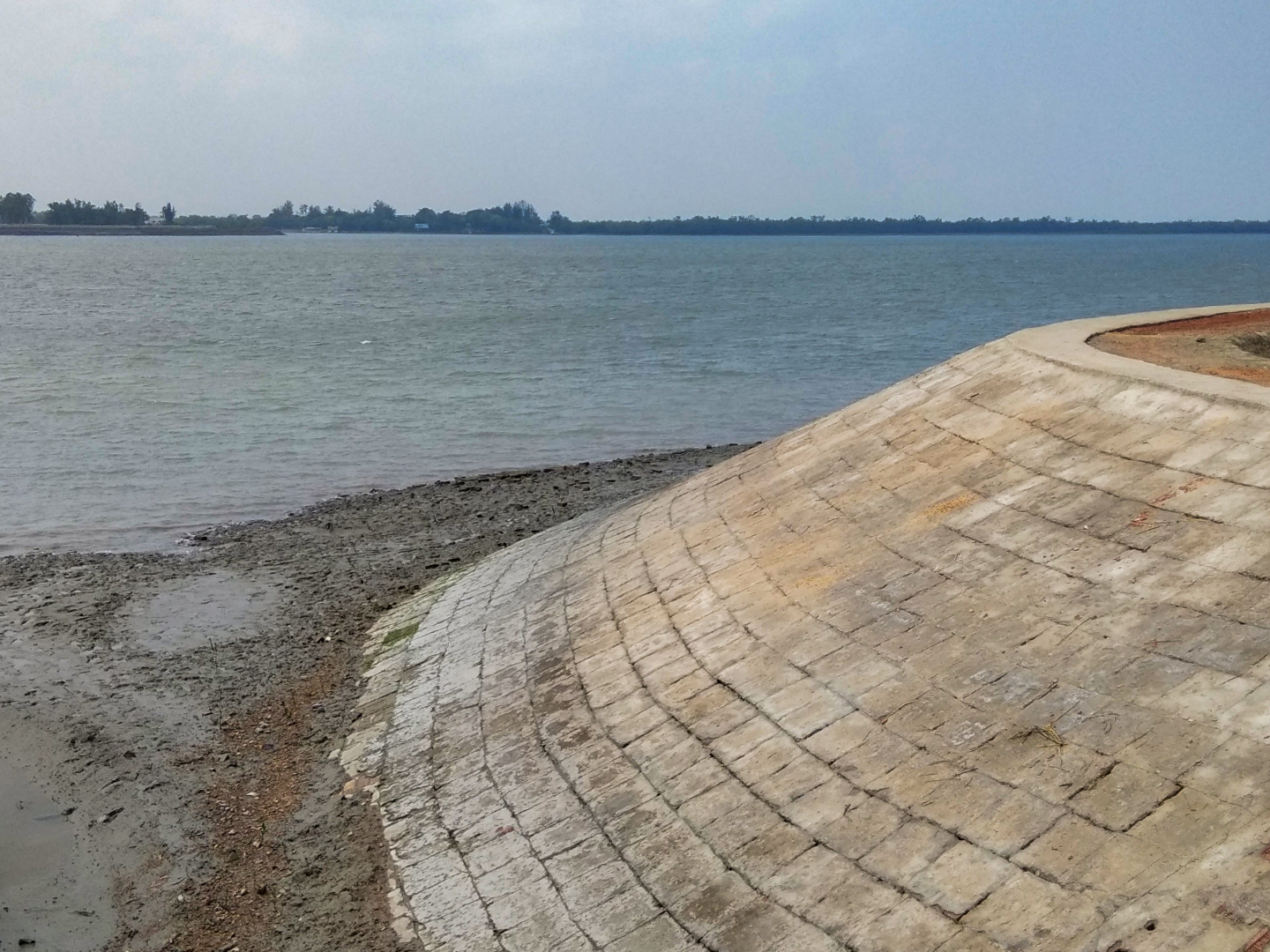
The extensive embankments in the Sundarbans, crucial to farming and controlling soil salinity, are steadily being eroded by the rising sea levels. (Photos: Urvashi Sarkar/PARI)
A research paper co-authored by Dr. Mitra describes the Sudarbans as ‘hypersaline’. “Water salinity has increased due to rising sea levels in the central part of Sundarbans. This is clearly linked to climate change,” says Dr Mitra.
Other researchers have noted that the siltation of the Bidyadhari river, which prevents fresh water flows from the Himalayas to the central and eastern Sundarbans. Researchers have attributed the siltation in part to land reclamation, cultivation, dumping of sewage sludge and fisheries waste. The building of the Farakka Barrage in 1975 (on the Ganga, in West Bengal’s Murshidabad district) also contributed to the increasing salinity of the central Sundarbans.
The Mondal family in Rajat Jubilee knows the effects of the high salinity – they had no rice to sell for three years after Aila. Their annual income of Rs. 10, 000- 12,000 from selling rice was wiped out. “With rice cultivation gone, entire villages emptied out as men left to hunt for work, to Tamil Nadu, Karnataka, Gujarat and Maharashtra, where they joined factories or construction sites as labourers,” Prafulla recalls.
Across the state, Aila affected more than 2 lakh hectares of cropped area and over 6 million people, and it killed 137 and destroyed over 1 million houses . “There was nobody in my village who did not suffer losses,” Prafulla says. “My house and crops were destroyed. I lost 14 goats and could not cultivate paddy for three years. Everything had to be rebuilt from scratch. Those were hard years. I took up carpentry and odd jobs to make a living.”
After Aila intensified salinity, Kajal Lata’s family too had to sell six bighas of their 23 bighas (7.6 acres) of land. “Not a blade of grass grew for two years because the soil was so salty. Not even rice could grow. Slowly, vegetables like mustard, cabbage, cauliflower and gourds are growing again, enough for our consumption, but not enough to sell,” she says. “We also had a pond which produced different fish like shol, magur, rui and we could earn Rs. 25,000-30,000 a year by selling these. But after Aila, the water became entirely salty, so there is barely any fish.”
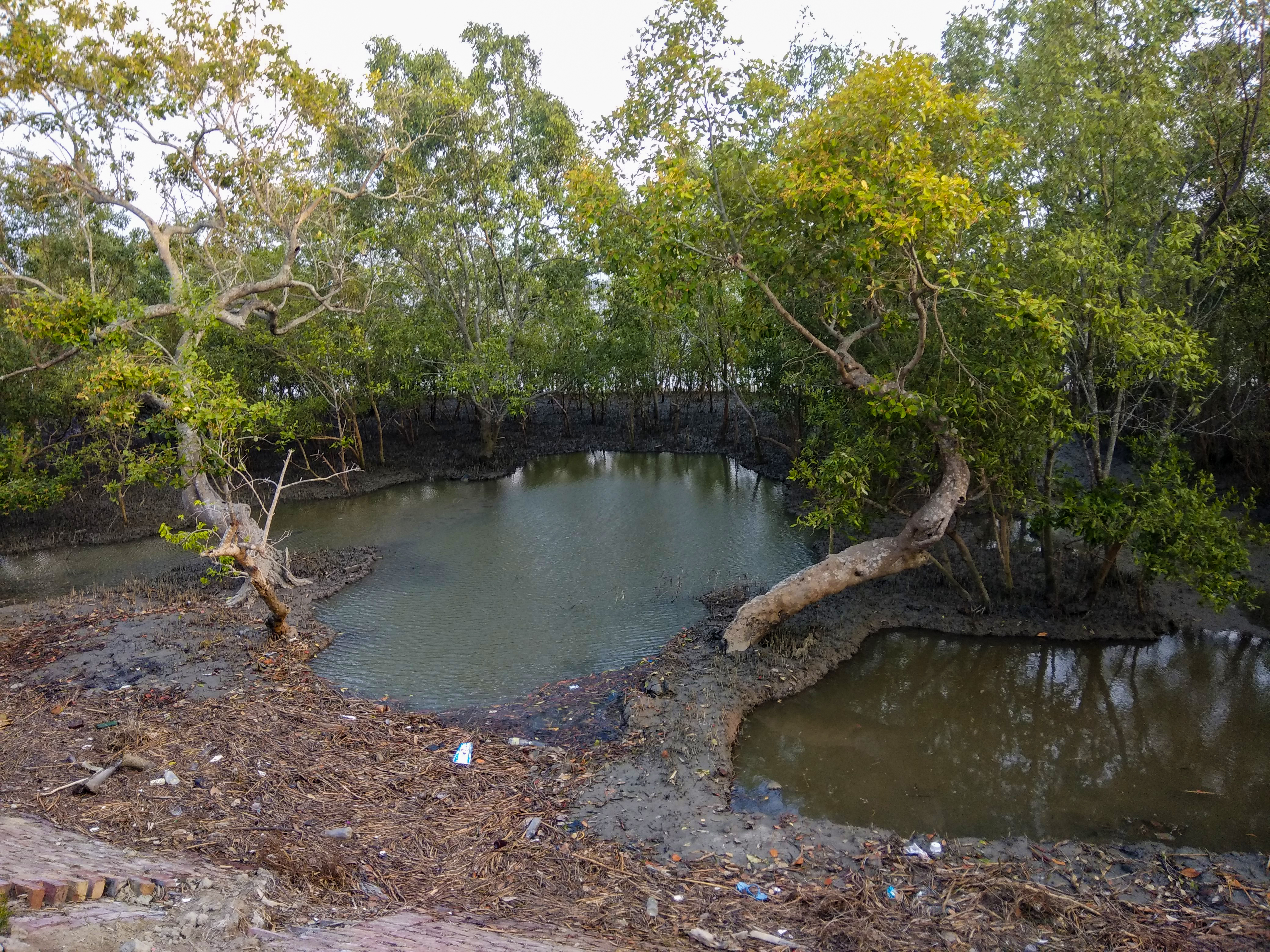
Mangroves are critical to the ecosystem of the Sundarbans... (Photo: Urvashi Sarkar/PARI)
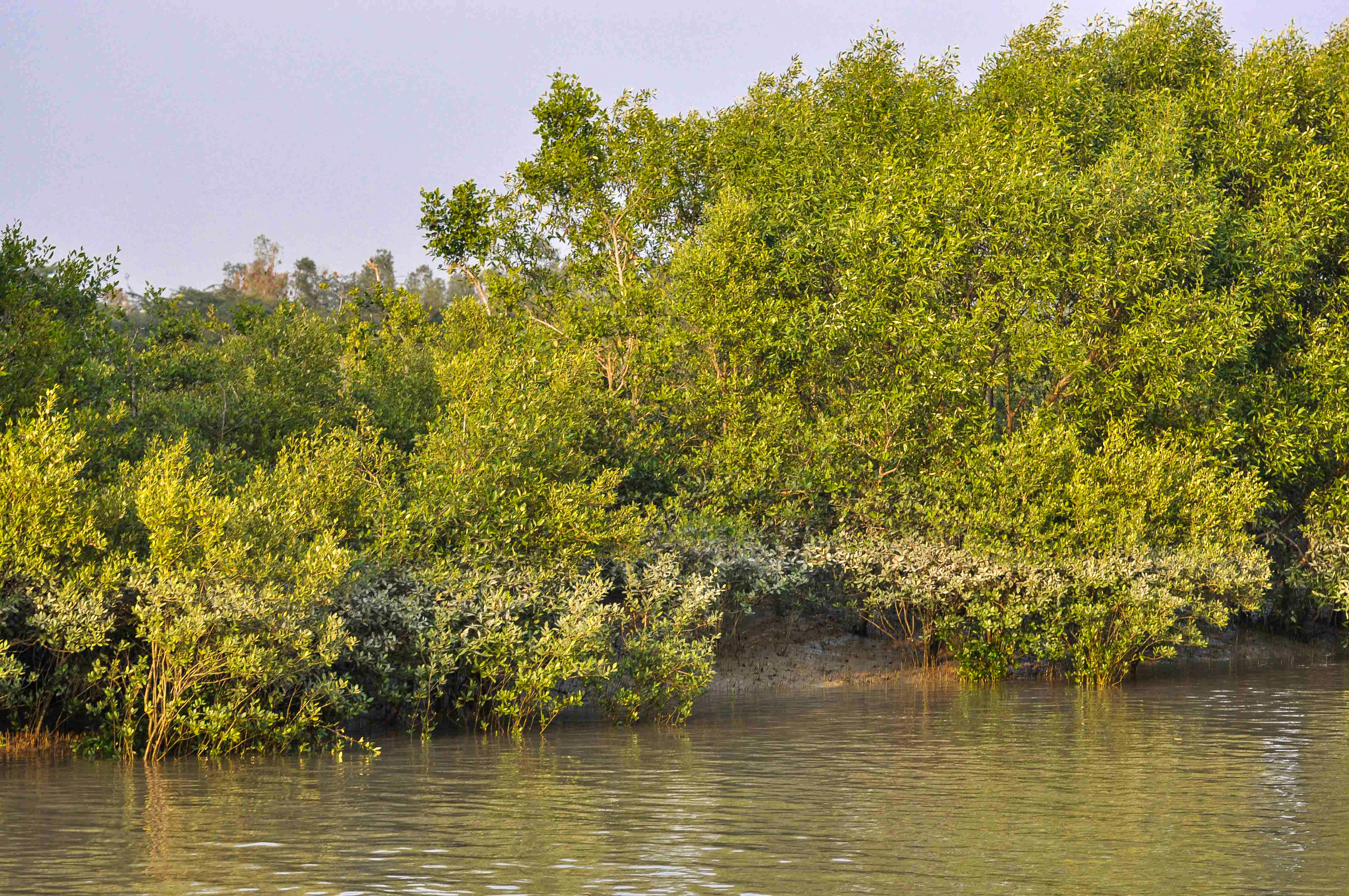
...But they too are slowly thinning out. (Photo: Ritayan Mukherjee/PARI)
The soil degradation – including high salinity and high alkalinity – caused by Aila resulted in poor paddy growth across much of the Sundarbans in North and South 24 Pargana, notes a 2016 paper in the Journal of Experimental Biology and Agricultural Sciences. A study in the journal shows that to grow paddy again, phosphate and potash-based fertiliser had to be used above the recommended levels.
“After Aila, fertiliser use has increased. Only then we are able to get the required yield,” says Prabir Mondal, Prafulla’s 48-year-old son. “It isn’t healthy to eat, but we still need to eat it. I remember the rice we ate as children. You could eat it as it is. Now, even when eaten with vegetables, something feels amiss.”
His father owns 13 bighas (4.29 acres) of land which produces 8-9 bastas of rice per bigha – one basta equals 60 kilos. “The cost of planting, cutting and lifting the rice plus fertiliser costs means that we earn very little over what we have spent,” says Prabir.
Paddy production across the Sundarbans, a 2018 research article observes, fell by half after Aila – from 64-80 quintal to 32-40 quintals per 1.6 hectares. Though paddy production has now stabilised to pre-Aila levels, says Prabir, his family and others in his village remain completely dependent on rainfall from June to September.
And that rainfall has become unreliable. “The accelerated sea level rise,” says Prof. Hazra, “and the delayed arrival and deficiency of monsoon, are impacts of climate change in the long run.”
High rainfall exceeding 100 millimetres a day is occurring more often in the last two decades over the northern Bay of Bengal (where the Sundarbans is located), says ongoing research at the School of Oceanographic Studies, Kolkata. At the same time, in the sowing season, Prof. Hazra says, the monsoon has often fallen short, as it did this year – till September 4, around 307 millimetres short in South 24 Parganas and nearly 157 mm less in North 24 Parganas.
It’s not just this year – a shortfall or excess rain has been recurring in the Sundarbans for some years. The normal June to September monsoon rain in South 24 Parganas is 1552.6 mm, says the West Bengal government’s annual flood report. The monsoon data for 2012-2017 the district indicates that rainfall was deficient in four of these six years, with major lows in 2017 (1173.3 mm) and 2012 (1130.4 mm).
In the North 24 Parganas, the opposite has happened: excess rainfall. The normal June to September rainfall here is 1172.8 mm. The monsoon data for 2012-2017 shows that rainfall was excess in four years with the highest in 2015 – 1428 mm.
“The real trouble is the untimely rain,” says Kajal Lata. “In February this year, there was plenty of rain, almost like monsoon. Even the elders said they could not recall a time when it rained so much in February.” Her family depends on paddy for an income, sown in June-July and harvested in November-December. “The paddy growth depends entirely on rainfall. If there is no rain, the rice will not grow.”
Since the last four or five years, she says, it’s been raining in her village in November-December, in addition to the monsoon months. While some showers during these months usually occur here, their intensity can harm the paddy harvest. “Either there is no rain when required or it rains excessively out of season. This is destroying the harvest. Every year we think this time there won’t be excessive [unseasonal] rain. But it rains so much and the crop is completely destroyed. That is why we have the saying, ‘Aashay morey chaasa’ [‘Hope kills the farmer’].”
In Rajat Jubilee village, Prabir Mondal is also worried. “Through June and July, there was no rainfall [in my village]. Some paddy leaves dried up. Thankfully, rain has arrived [in August]. But will it be enough? What if it rains too much and the crop drowns?”
As a healthcare practitioner (he has a BA degree in alternative medicine), Prabir says his patients also increasingly complain of the heat. “Many now suffer from heat stroke. It can hit at any time and can be fatal,” he explains.
Land temperatures in the Sundarbans are also increasing, besides the rising sea surface temperatures. From 180 days in a year when the temperature was 32 degrees Celsius or higher here in 1960, the number of such days increased to 188 in 2017, show data on an interactive portal of the New York Times on climate and global warming. This could become 213 to 258 days by the end of the century.
Buffeted repeatedly by the growing heat, cyclones, erratic rain, salinity, vanishing mangroves and more, the residents of the Sundarbans live in a near-constant state of uncertainty. Prafulla Mondal, witness of several storms and cyclones, wonders: “Who knows what will come next?
Urvashi Sarkar is an independent journalist and a 2016 PARI Fellow.
PARI’s nationwide reporting project on climate change is part of a UNDP-supported initiative to capture that phenomenon through the voices and lived experience of ordinary people. These stories are simultaneously available on the PARI website at https://ruralindiaonline.org
Want to republish this article? Please write to zahra@ruralindiaonline.org with a cc to namita@ruralindiaonline.org

 Locations
Locations